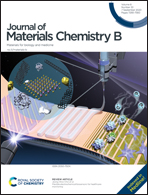Growth of large-scale MoS2 nanosheets on double layered ZnCo2O4 for real-time in situ H2S monitoring in live cells†
Abstract
There is an urgent need to develop in situ sensors that monitor the continued release of H2S from biological systems to understand H2S-related pathology and pharmacology. For this purpose, we have developed a molybdenum disulfide supported double-layered zinc cobaltite modified carbon cloth electrode (MoS2–ZnCo2O4–ZnCo2O4) based electrocatalytic sensor. The results of our study suggest that the MoS2–ZnCo2O4–ZnCo2O4 electrode has excellent electrocatalytic ability to oxidize H2S at physiological pH, in a minimized overpotential (+0.20 vs. Ag/AgCl) with an amplified current signal. MoS2 grown on double-layered ZnCo2O4 showed relatively better surface properties and electrochemical properties than MoS2 grown on single-layered ZnCo2O4. The sensor delivered excellent analytical parameters, such as low detection limit (5 nM), wide linear range (10 nM–1000 μM), appreciable stability (94.3%) and high selectivity (2.5-fold). The practicality of the method was tested in several major biological fluids. The electrode monitors the dynamics of bacterial H2S in real-time for up to 5 h with good cell viability. Our research shows that MoS2–ZnCo2O4–ZnCo2O4/carbon cloth is a robust and sensitive electrode to understand how bacteria seek to adjust their defense strategies under exogenously induced stress conditions.



 Please wait while we load your content...
Please wait while we load your content...